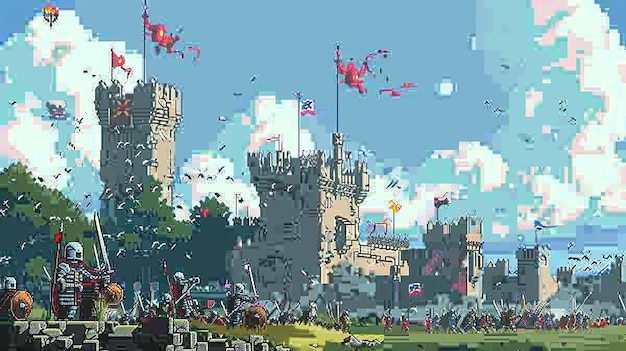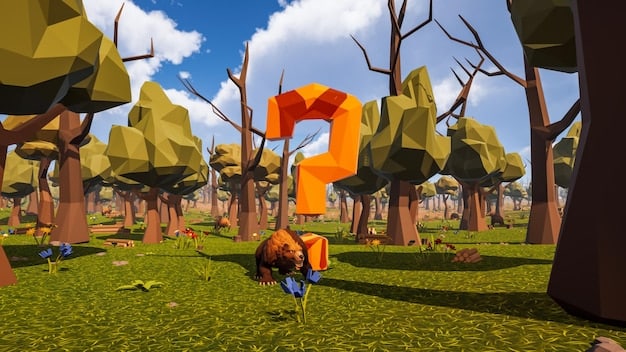Roguelike Renaissance: Why Indie Devs & Gamers Are Hooked

The rise of the roguelike genre in the indie scene is due to its blend of challenging gameplay, replayability, and innovative design, attracting both developers and players seeking unique gaming experiences.
The indie gaming world is currently witnessing a fascinating phenomenon: the explosive rise of the roguelike genre. But what’s fueling this surge in popularity? Why are indie developers so drawn to creating these challenging, replayable experiences, and why are gamers so addicted to playing them? The Rise of the Roguelike: Why This Genre Is Dominating the Indie Scene, with 3 Examples, will explore the reasons behind this trend, showcasing standout examples that exemplify the genre’s appeal.
What Defines A Roguelike Game?
Before diving into the reasons for the genre’s current dominance, it’s crucial to understand what exactly constitutes a roguelike game. While the term might conjure up images of nostalgic, pixelated adventures, the definition is actually quite specific, rooted in the design of the original game, Rogue.
Essentially, roguelikes are characterized by several key elements that differentiate them from other genres.
Core Elements of a Roguelike
These elements collectively create a unique gaming experience focused on challenge, risk-taking, and adaptation.
- Procedural generation: Levels, items, and enemies are randomly generated each time you play, guaranteeing a fresh experience with every run.
- Permadeath: When your character dies, that’s it – game over. You start from the beginning, losing all progress and items.
- Turn-based gameplay: Actions are performed in discrete turns, allowing players to carefully consider their moves and strategies.
- Grid-based movement: Characters and enemies move on a grid, creating a tactical and strategic combat environment.
- Resource management: Players must carefully manage limited resources like health, ammunition, and consumables to survive.
These core elements ensure that each playthrough is a uniquely challenging experience, demanding adaptability and strategic thinking from the player.
In short, roguelikes offer a gaming experience that is both challenging and rewarding, requiring players to learn from their mistakes and adapt to ever-changing circumstances. This inherent difficulty, combined with the thrill of permadeath, creates a compelling gameplay loop that keeps players coming back for more.
The Allure Of Challenge And Replayability For Players
A significant part of the genre’s appeal lies in the challenge and replayability it offers. In an era dominated by increasingly accessible and forgiving games, roguelikes stand out as a bastion of old-school difficulty that rewards skill and strategy.
The draw for players is multi-faceted.
Constantly Adapting
The combination of procedural generation and permadeath creates a high-stakes environment where every decision matters. Players are constantly forced to adapt to new situations, learn enemy patterns, and optimize their strategies on the fly.
This contrasts sharply with many modern games that offer a more curated and forgiving experience.
Bragging Rights
The difficulty of roguelikes can be a major draw for players seeking a challenge. Overcoming the odds in a roguelike, beating a particularly difficult boss, or achieving a truly impressive run can provide a sense of accomplishment that few other games can match.
Furthermore, the random nature of each playthrough ensures that success is never guaranteed, making each victory all the more satisfying.

The roguelike genre attracts players due to its demanding gameplay, which fosters a sense of mastery and accomplishment with each successful run. This intrinsic reward loop, coupled with the thrill of overcoming challenging obstacles, keeps players engaged and invested in the experience.
Indie Darling: Why Developers Love Roguelikes
From the developer’s perspective, the roguelike genre offers numerous advantages. The procedural generation mechanic allows smaller teams to create vast and varied experiences without the need for extensive content creation.
This efficiency makes it an ideal choice for independent developers.
Lower Development Costs
Compared to AAA titles with sprawling open worlds and meticulously crafted narratives, roguelikes can be developed with significantly smaller budgets. The focus on gameplay mechanics and emergent storytelling allows developers to prioritize innovation and experimentation over graphical fidelity and cinematic presentation.
This democratization of game development enables smaller studios to compete with larger companies, bringing unique and creative ideas to market.
Unlimited Replayability
From a design viewpoint, roguelikes are a gift that keeps on giving. When the core mechanics have been polished, the replayability is virtually limitless.
- Players return to the game repeatedly, generating value far beyond initial development investment.
- Developers gain continuous feedback, shaping future updates and expansions.
- The community thrives on shared experiences, strategies, and custom content.
Developers find roguelikes to be a strategic investment, offering expansive gameplay and ongoing community interaction. This ongoing engagement provides a continuous stream of feedback and opportunities for growth, making it a sustainable and fulfilling genre for indie creators.
Spotlight: 3 Roguelike Games Dominating The Indie Scene
To illustrate the diverse landscape of the roguelike genre, let’s take a closer look at three examples that have captured the hearts and minds of indie gamers.
Each title showcases a different facet of the roguelike formula, highlighting the genre’s versatility and potential for innovation.
Hades: Narrative Depth and Combat Prowess
Supergiant Game’s Hades merges the demanding gameplay of roguelikes with rich, character-driven narrative, offering a compelling reason to keep playing even as you repeatedly escape the underworld.
Key Features:
- Fast-paced, action-packed combat
- Deep, branching narrative with memorable characters
- Stunning art style and soundtrack
Dead Cells: Fluid Combat and Exploration
Motion Twin’s Dead Cells features fluid combat mechanics and expansive non-linear levels. It marries roguelike elements with Metroidvania exploration, to produce a smooth, action-packed experience emphasizing skill and discovery.
Distinct Qualities:
- Tight, responsive controls and buttery smooth animation
- A wide array of weapons, skills, and upgrades
- Interconnected levels that reward exploration

Slay the Spire: Deckbuilding and Strategy
Mega Crit Games’ Slay the Spire merges deckbuilding elements with roguelike mechanics to craft a deeply strategic, endlessly replayable game.
Highlight Elements:
- Addictive deckbuilding system with hundreds of cards
- Four unique characters, each with their own card pool and playstyle
- Challenging encounters that require careful planning and execution
These 3 titles not only demonstrate the appeal of roguelikes, but also the creative ways in which developers are pushing the genre forward. By combining traditional rogue-like elements with novel mechanics and engaging themes, these games broaden the appeal of the genre while remaining true to its core tenets.
The Evolution Of Roguelikes: “Roguelites” And Beyond
As the genre has evolved, so has the terminology used to describe the games within it. The term “roguelite” has emerged to describe games that borrow elements from roguelikes but offer a more forgiving experience.
This has led to debates and discussions within the gaming community about what truly defines a roguelike.
Roguelike Vs Roguelite
The primary distinction between roguelikes and roguelites lies in the permanence of progress. In traditional roguelikes, death is typically a complete reset, whereas in roguelites, players may retain some form of progress or unlockables between runs.
Here’s what to consider:
- Roguelikes follow the original formula strictly, emphasizing permadeath and procedural generation.
- Roguelites offer a more accessible experience, often with meta-progression systems.
Blurring The Lines
The term “metroidvania” describes games focused on world exploration and permanent power-ups, and sometimes it mixes with roguelites.
This overlap has allowed the genre of roguelites to appeal to a wider audience who might otherwise be put off by the harshness of traditional roguelikes.
Both terms describe games that share similar qualities, often causing them to be confused in the gaming community. The most important takeaway is that while rogue-likes adhere to specific traditional mechanics, roguelites allow for permanent upgrades or progress, and introduce different mechanics.
The Future Of Roguelikes In Indie Gaming
The roguelike genre is not just a passing fad; it represents a fundamental shift in the way games are designed and experienced. Its focus on emergent gameplay, challenging difficulty, and endless replayability makes it a perfect fit for the indie scene, where innovation and creativity are highly valued.
The genre’s future looks bright.
Continued Innovation
As indie developers continue to experiment with the roguelike formula, we can expect to see even more innovative and genre-bending titles emerge in the coming years.
Think novel combinations with RPGs, simulators, and strategy games.
Growing Acceptance
As more players discover the unique appeal of roguelikes, the genre will continue to grow in popularity and influence, shaping the landscape of indie gaming for years to come.
This increased acceptance may even spill over into the mainstream, with larger studios incorporating roguelike elements into their own games.
Roguelikes will continue to evolve, inspiring a generation of developers and captivating players with their intricate blend of challenge and replayability, solidifying its place as a cornerstone of the indie gaming scene.
| Key Point | Brief Description |
|---|---|
| 🎲 Procedural Generation | Creates unique experiences each playthrough. |
| 💀 Permadeath | Adds high stakes and encourages strategic play. |
| 🕹️ Indie Appeal | Low development costs and high replayability for indie devs. |
| 📈 Genre Evolution | Roguelites offer a more accessible and modern twist. |
Frequently Asked Questions
▼
Roguelikes are characterized by procedural generation, permadeath, turn-based gameplay, grid-based movement, and strategic resource management. These elements combine to create a challenging yet rewarding gameplay loop.
▼
Roguelikes appeal to indie developers due to their lower development costs and high replayability. Procedural generation allows small teams to create a vast amount of content without extensive resources.
▼
Successful roguelike games include Hades, known for its narrative depth, Dead Cells, celebrated for its fluid combat, and Slay the Spire, admired for its strategic deckbuilding mechanics.
▼
The main difference lies in the permanence of progress. Roguelikes feature complete resets upon death, while roguelites allow players to retain some form of progress or unlockables, making them more accessible.
▼
The future of roguelikes is bright, with continued innovation and growing acceptance in the gaming community. Expect to see more genre-bending titles emerge as developers experiment with new combinations and mechanics.
Conclusion
Ultimately, the rise of the roguelike genre in the indie scene is a testament to the power of challenging gameplay, endless replayability, and innovative design. As more and more developers embrace the roguelike formula, we can expect to see even more thrilling and unforgettable gaming experiences emerge in the years to come, solidifying its place as a staple in gaming.





